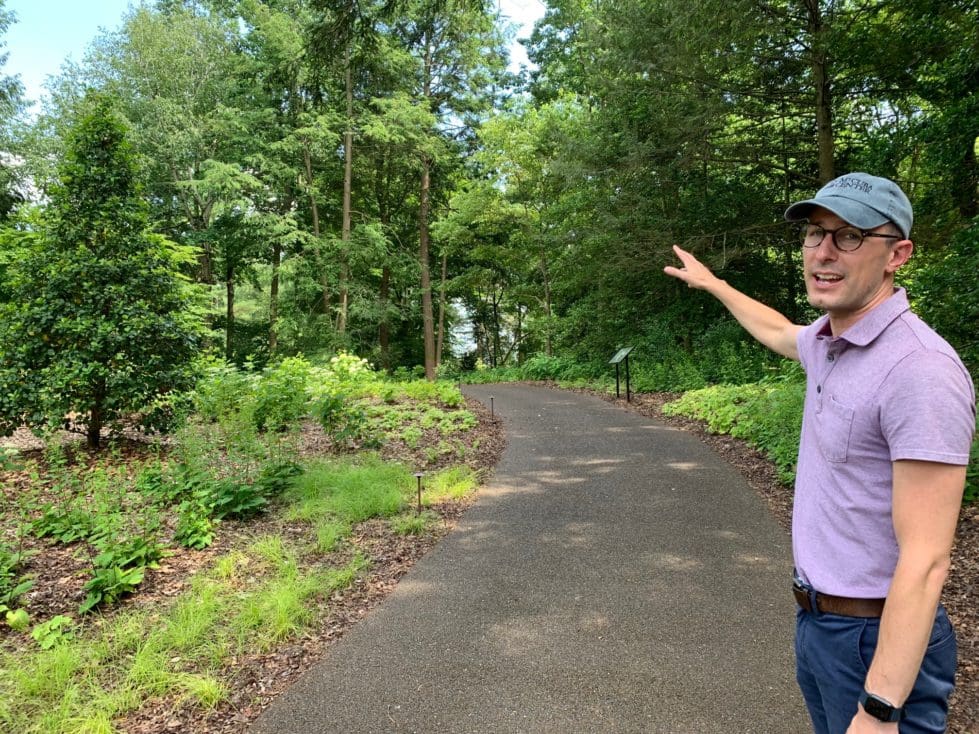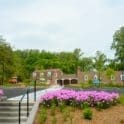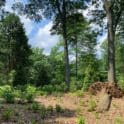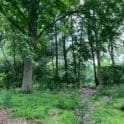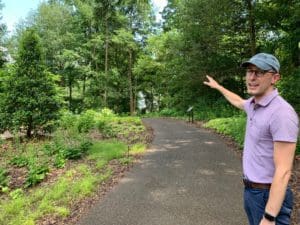

George Coombs, Mt. Cuba director of horiticulture, talks about the new Woodland Glade entrance path.
Mt. Cuba Center has used old spaces, 12,000 native plants and environment-friendly materials to give patrons a more charming way to enter its botanic gardens.
Visitors now may park in a new well-landscaped two-level lot. It leads them to a building once used as staff housing where patrons may buy tickets on the way in and Mt. Cuba plants on the way out.
Patrons previously had to make their way from a primitive parking lot to the Pamela and Lammot du Pont Copeland house for admission tickets.
Now, said George Coombs, director of horticulture, the Mt. Cuba garden experience begins immediately.
Guests will cross the main drive for a 700-foot Woodland Glade walk to the terrace outside the Copeland House through an area that previously had not been available to visitors.
Mt. Cuba parking
A formal entry became necessary in the last decade on what was once private property with limited parking near the house.
The late Pamela and Lammot du Pont Copeland bought the property in 1935 and transformed farmland into Mt. Cuba’s lush botanical gardens. Along the way, they hired famed landscape designer Marian Coffin and landscape architect Seth Kelsey, among others, to help.
The property was incorporated as a foundation in 1989 and began to transition into a public garden in 2002.
For a long time, the only way to get onto the property was to attend a class. In 2005, it opened to the public for one day with its first Wildflower Celebration. The enthusiastic crowds stunned planners and backed up area roads for miles as people waited for their turn to enter.
Since then, the gardens have gradually opened more and more, hosting various events and recently selling memberships.
Because Mt. Cuba was not designed for the public, parking was minimal, with 42 spots carved out of the woods and overflow parking on a grassy hill nearby.
“As our visitation has been growing, we just really didn’t have room to park the number of guests that we get, particularly when a bus shows up,” Coombs said.
A master plan adopted a few years ago made parking a priority. Planning for the next entrance began in December 2019. The bi-level lot holds 73 spaces with room for buses. Overflow will go into the old lot, which held 42.
- A building once used for staff when Mt. Cuba was a family home has been repurposed into a place to buy admission tickets and plants.
- The new Mt. Cuba parking lot is paved with porous asphalt draining water into underground cisterns to prevent erosion of the hill it sits on.
- The Woodland Glade entry at Mt. Cuba is a 700-foot path with pathways that allow rain to flow through the walkway into the soil substructure.
The entrance path starts with the first of three unique garden areas — a clearing where the sun shines on ‘Haas Halo’ lacecap hydrangeas, heuchera, tiarella, sedges and ferns artfully planted around a tree that came down during the 2020 tornadoes that moved through the area.
“We decided to keep it and when it first fell, it was laying kind of high up and out of the ground,” Coombs said. “We wanted to make it look like it’s been there longer. So we actually lifted it up, dug out underneath and kind of sunk it down lower so it looked like it had been rotting and decaying over time.”
The materials for the parking lot and for the new walking paths allow water to seep right through into the ground or into underground cisterns. That helps curtail run-off and erosion.
Sustainable paving
The walkways use Porous Pave.
“It’s actually made from recycled tires,” Coombs said. “They are laid down with this polymer that creates a porous structure so water goes immediately through and down into the ground. Again, not contributing to run off or erosion.”
The parking lot’s porous asphalt allows water to seep into underground cisterns filled with gravel. They will allow water to slowly seep into the ground.
“And if it’s a really bad rain, one kind of just overflows into the next,” he said. “That all happens underground.”
The lots rest on a hillside and the cisterns protect it, especially in heavy rains.
“Slopes can erode and trees get damaged,” Coombs said. “Managing the storm water was really important.”
The parking lot is landscaped with native plants that hint at what guests will see in the gardens. Most of the plantings are young and seem sparse, but will mature into lushness, Coombs said.
Trees include tulip poplars, sugar maples, red maples, red buds, red oaks, sour gums, swamp white oaks and dogwoods. Beds are planted with oakleaf hydrangeas, witch hazel, azaleas and rhododendron.
- The tree in Mt. Cuba’s Woodland Glade fell during the 2020 tornadoes, but was buried deeper for aesthetics.
- This yellowwood tree is surrounded by plantings of phlox that did well in a garden trial.
- The Lookout at Mt. Cuba offers a view that on a good day includes the Delaware Memorial Bridge.
Many of the plantings and landscaping decisions do double duty.
Not only was the downed tree a cool focal point, but woody debris is valuable in a garden, Coombs said.
It feeds fungi in soil and will help the 100-plus Lady Slipper Orchids planted in the area to grow. They like woody areas, he said. When found in the wild, they are always in those kind of areas.
“They have these very specialized, wonderful relationships with stuff in the soil,” he said. “They need a certain thing to germinate their seed. They need another thing to grow and live for years. So it kind of helps tell that story about what these kinds of plants require.”
One of the plants Mt. Cuba used for planting was the Alabama warbonnet (Jamesianthus alabamensis). It’s considered rare with small populations in Alabama and George, mostly in the mountains, but spilling into the Piedmont that Delaware is part of.
They grow 3 to 4 feet tall with bright yellow flowers and like lightly shaded, moist streambanks. Mt. Cuba and a few other botanic gardens plant them to be sure that if something happens to the Alabama and Kentucky plants, the species isn’t lost.
Another garden along the entrance walk features a towering yellowwood tree, which produces wisteria-like flowers. Surrounding it are phlox amplifolia, a winner from another Mt. Cuba garden trial.
The final garden is The Lookout. There, benches that the Copelands installed offer a sweeping view of Mt. Cuba’s rolling hills. On a clear day, visitors can see the Delaware Memorial Bridge in the distance.
Soon, they will also be able to see Mt. Cuba’s new 14,000-square-foot greenhouse, which is under construction but will be partly hidden by trees.
Designers expanded the bluestone patio at the Lookout to create a bigger oasis and installed an information sign so visitors would know more about what they are seeing.


Betsy Price is a Wilmington freelance writer who has 40 years of experience.
Share this Post

